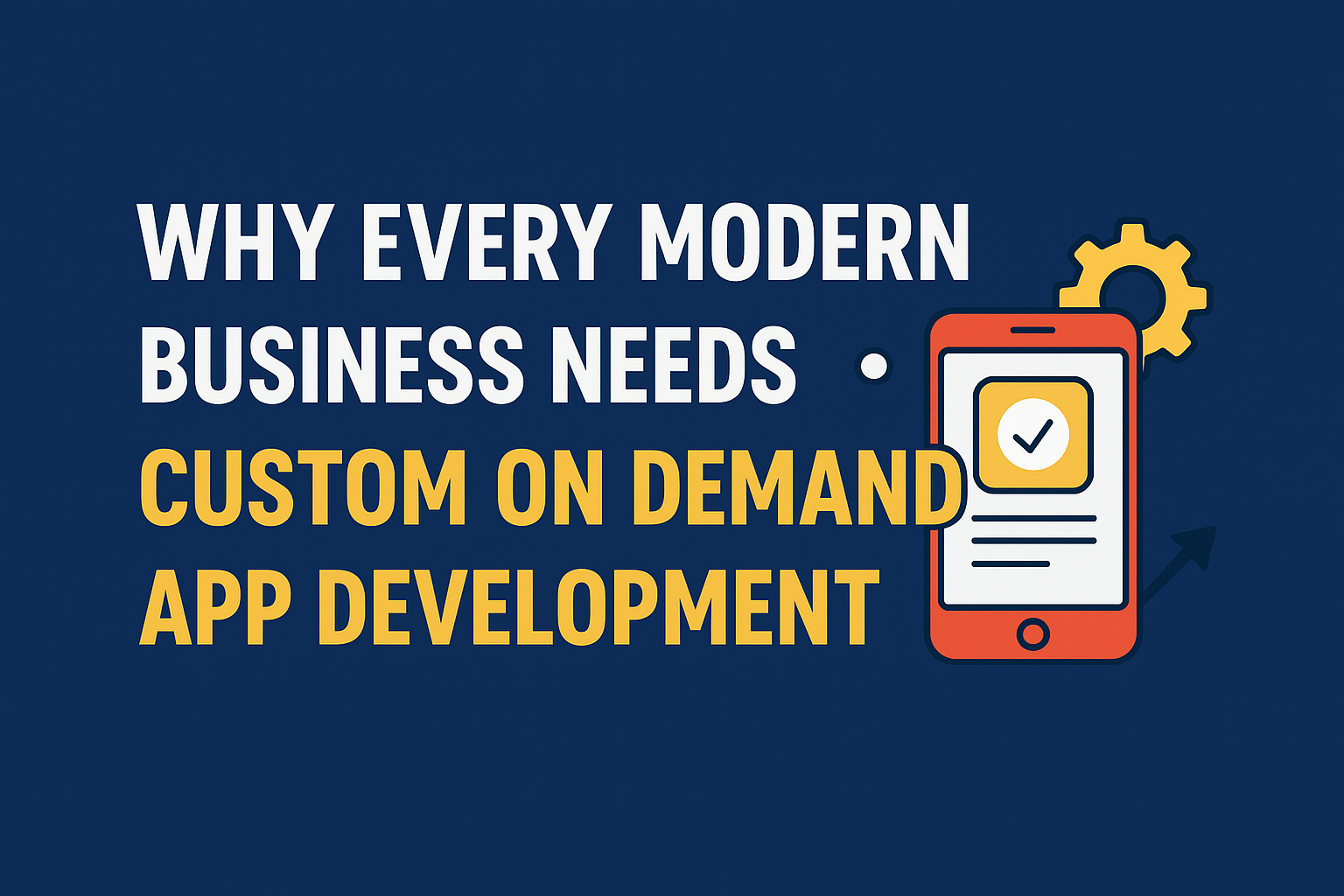In today’s fast-paced digital landscape, businesses must adapt quickly to evolving customer demands, technological advancements, and competitive pressures. One of the most powerful ways to achieve this is through custom on demand app development. Unlike generic applications, custom-built on demand apps are designed specifically around a business’s goals, target audience, and operational needs.
This article explores in detail why every modern business needs custom on demand app development, covering the benefits, use cases, and strategies that make it a critical investment for growth and sustainability.
Understanding Custom On Demand App Development
Before exploring its impact, it’s important to first understand what custom on demand app development really means and why it differs from generic solutions.
What Is On Demand App Development?
On demand app development refers to building mobile or web applications that allow users to request services or products instantly, with seamless delivery or access. Common examples include apps like Uber, DoorDash, Zomato, Instacart, or even healthcare consultation platforms.
What Makes It Custom?
While off-the-shelf solutions provide generic features, custom on demand app development tailors the platform to fit a business’s specific workflows, branding, and customer expectations. It includes personalized design, integration with business systems, unique features, and advanced scalability options.
Why Modern Businesses Cannot Ignore Custom On Demand Apps
In an era where customer demands and technology evolve rapidly, ignoring custom on demand app development can leave businesses far behind their competitors.
1. Meeting Customer Expectations in the Digital Age
Consumers today expect services at their fingertips—fast, convenient, and reliable. Whether ordering food, booking a taxi, or scheduling home cleaning, people prefer digital-first solutions. A custom on demand app ensures businesses meet these high expectations with tailored features such as:
- One-click booking or ordering
- Real-time tracking of services or deliveries
- Personalized recommendations
- Secure and seamless payment options
When businesses fail to meet these expectations, customers often switch to competitors who do.
2. Driving Business Efficiency
Custom apps are not just for customer-facing interactions; they also streamline internal business operations. By integrating with inventory systems, CRM platforms, and analytics tools, businesses can:
- Automate routine processes
- Manage staff scheduling and assignments
- Track supply chains in real-time
- Reduce operational costs
For example, a logistics company can use a custom on demand app to assign delivery tasks, track driver performance, and optimize routes—all in one platform.
3. Unlocking New Revenue Streams
A significant benefit of custom on demand app development is the opportunity to introduce new revenue models. Businesses can add:
- Subscription services for premium features
- In-app advertisements
- Commission-based earnings from vendors or partners
- Loyalty programs to encourage repeat customers
These monetization strategies not only diversify income but also increase customer lifetime value.
4. Strengthening Brand Identity
Off-the-shelf apps often lack flexibility in branding. In contrast, custom apps allow businesses to create a unique identity through personalized UI/UX design, tailored user flows, and consistent brand elements. A strong brand presence within an app:
- Builds trust with customers
- Encourages brand recall
- Sets the business apart from competitors
When customers interact with a smooth, professional, and branded app, it enhances overall brand credibility.
5. Scalability for Future Growth
As businesses expand, their digital platforms must evolve accordingly. Custom on demand apps are designed with scalability in mind, allowing companies to:
- Add new features without disrupting existing services
- Handle increased traffic during peak times
- Expand to new markets or regions seamlessly
For instance, a food delivery startup can begin with basic features and gradually scale to include AI-driven recommendations, drone deliveries, or blockchain-based payments as the business grows.
6. Enhanced Customer Insights
One of the biggest advantages of digital platforms is data. Custom apps are built with analytics tools that allow businesses to track user behavior, preferences, and patterns. Insights from these analytics help companies:
- Personalize marketing campaigns
- Improve product or service offerings
- Predict customer needs
- Identify high-performing services or products
This data-driven approach ensures decisions are backed by real-time insights, improving customer satisfaction and profitability.

Real-World Use Cases of Custom On Demand App Development
The best way to see the power of custom on demand apps is to look at real-world examples where industries are already leveraging them for success.
1. Healthcare
Telemedicine apps allow patients to consult doctors instantly, book appointments, and access prescriptions online. Customization ensures compliance with data security standards like HIPAA and local regulations.
2. Transportation & Logistics
Ride-hailing and delivery apps benefit from features like GPS tracking, automated driver assignments, and real-time route optimization.
3. Retail & E-Commerce
Custom apps provide businesses with options like AI-driven product recommendations, personalized discount offers, and seamless checkout experiences.
4. Food & Hospitality
Restaurants and hotels use custom on demand apps for table reservations, food ordering, and contactless delivery, enhancing customer convenience.
5. Professional Services
From home cleaning to salon appointments, service-based businesses rely on on demand apps to connect professionals with customers quickly and efficiently.
How to Get Started with Custom On Demand App Development
Building a successful on demand app requires a clear roadmap that aligns business goals with the right technology and development strategy.
Step 1: Identify Business Needs
Define the specific problems you want the app to solve. Is it to attract new customers, improve operations, or expand into new markets?
Step 2: Choose the Right Features
Based on your target audience, decide which features are essential—real-time tracking, secure payments, chat support, or AI-based recommendations.
Step 3: Partner with Experienced Developers
Working with skilled developers ensures the app is secure, scalable, and user-friendly. They can also guide you on integrating emerging technologies like AI, blockchain, and IoT.
Step 4: Test & Optimize
Before launching, conduct extensive testing to ensure smooth performance, bug-free operations, and a positive user experience. Continuous updates and feedback integration are key.
Step 5: Focus on Marketing & Adoption
Even the best app fails without visibility. Use digital marketing, referral programs, and social media campaigns to attract users and encourage adoption.
The Future of On Demand App Development
The on demand economy is expected to grow exponentially, fueled by advancements in artificial intelligence, automation, and 5G technology. Future custom on demand apps will likely include:
- AI-powered chatbots for instant support
- AR/VR integration for immersive experiences
- Blockchain technology for secure transactions
- Predictive analytics for better customer engagement
Businesses investing today in custom solutions will have a clear competitive edge tomorrow.
Conclusion
In a digital-first world, custom on demand app development is no longer optional—it’s essential. From meeting customer expectations and improving operational efficiency to unlocking revenue streams and enhancing brand identity, the benefits are undeniable. Modern businesses that embrace this technology can scale faster, innovate continuously, and deliver unmatched value to their customers.
Whether you are a startup or an established enterprise, building a tailored on demand app can be the game-changing step that propels your business into the future.



